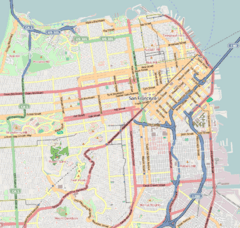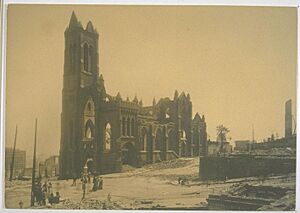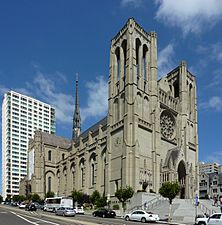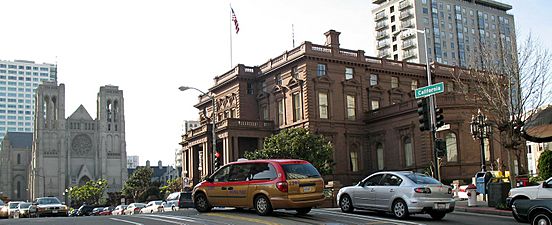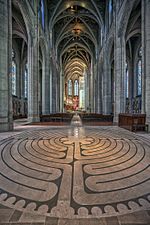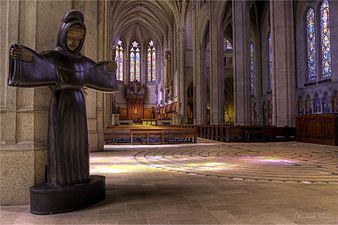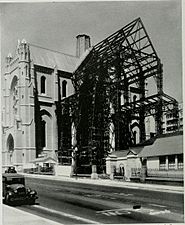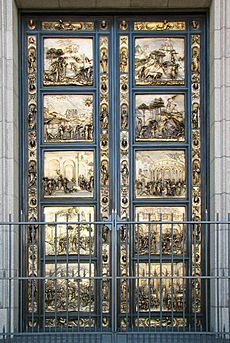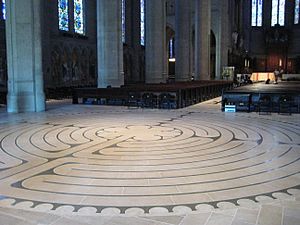Grace Cathedral, San Francisco facts for kids
Quick facts for kids Grace Cathedral |
|
|---|---|
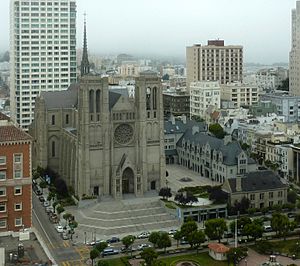
Cathedral and adjacent (right) headquarters of the Episcopal Diocese of California
|
|
| Religion | |
| Affiliation | Episcopal Church |
| District | Nob Hill |
| Region | United States |
| Ecclesiastical or organizational status | Cathedral |
| Leadership | Dean: Malcolm Clemens Young Bishop of California: Marc Andrus |
| Status | Active |
| Location | |
| Location | |
| State | California |
| Architecture | |
| Architect(s) | Lewis P. Hobart |
| Architectural style | French Gothic |
| Groundbreaking | 1927 |
| Completed | 1964 |
| Specifications | |
| Direction of façade | East |
| Length | 329 feet (100 m) |
| Width | 162 feet (49 m) |
| Height (max) | 174 feet (53 m) |
| Designated: | August 5, 1984 |
| Reference #: | 170 |
Grace Cathedral is a famous church in San Francisco, California. It is a large and important church for the Episcopal Church in the United States. You can find it on top of Nob Hill, a well-known area in San Francisco.
Grace Cathedral is the main church for the Episcopal Diocese of California. The current leader of the diocese is Bishop Marc Andrus. The local church community at Grace Cathedral is led by Dean Malcolm Clemens Young.
The church community started way back in 1849. Their first church building was destroyed in the big 1906 San Francisco earthquake. After that, they built a temporary church in 1907. They worked hard to raise money and began building the current cathedral in 1927. People started using parts of it in 1934, and the whole building was finally finished in 1964.
Grace Cathedral is famous for many things. It has beautiful murals by Jan Henryk De Rosen. You can also see a copy of the famous "Gates of Paradise" doors from Florence, Italy. Inside and outside, there are two special walking paths called labyrinths. The church also has amazing stained glass windows, a special chapel with art by Keith Haring, and a unique artwork called Our Lady of the Flowers by David LaChapelle. It also has a large carillon with 44 bells, three organs, and several choirs.
Contents
History of Grace Cathedral
The church community that became Grace Cathedral began in 1849. This was during the California Gold Rush, when many people came to California. The first church was called Grace Church.
In 1862, construction started on a new, larger church building. This impressive church was finished and opened in 1868. Many important people from San Francisco joined this church, including Leland Stanford and William Henry Crocker.
Sadly, in 1906, a huge earthquake hit San Francisco. A fire followed the earthquake and destroyed the church building. After this, the Grace church community quickly opened a temporary place to worship in 1907.
The family of William Henry Crocker, a rich banker, gave their land on Nob Hill to build a new, grand cathedral. This new cathedral took the name and community from the old Grace church.
Work on the new cathedral began in 1910. The design was in the English Gothic style. It was first planned by George Frederick Bodley from London. After he passed away, Lewis P. Hobart from San Francisco finished the plans.
The church community slowly raised money to build parts of the cathedral. They moved services into a small finished section in 1912. Later, they moved into the larger crypt (a basement area) when it was done in 1914. In 1927, they started a big fundraising effort to finish the entire cathedral.
Building continued for the next six years. However, the Great Depression made it hard to raise money. By 1934, Grace church was able to hold services in the main part of the cathedral. Construction paused until 1960, except for one of the two bell towers, which took seven years to build (1936–1943).
For 17 years, the cathedral remained partly built. Then, in 1960, construction started again. The cathedral was finished quickly and was completed in 1964. It became the third largest Episcopal cathedral in the United States.
On March 28, 1965, Martin Luther King Jr. gave a famous sermon at Grace Cathedral. This was part of the celebration for the cathedral's completion. About 5,000 people came to hear him speak. It was the largest gathering at the cathedral for many years.
Design and Special Features
-
Crest of Nob Hill, with Flood Mansion
-
Beniamino Bufano's statue of Saint Francis
The cathedral's design was inspired by famous French Gothic cathedrals. These include cathedrals in Amiens, Paris, and Chartres. The inside of Grace Cathedral is also inspired by other beautiful churches.
Grace Cathedral is 329 ft (100 m) long. It is 162 ft (49 m) wide at its widest point. The central spire, a tall, pointed part of the roof, rises 247 ft (75 m) above the street. The two main towers are 174 ft (53 m) tall.
Art by Jan Henryk De Rosen
Grace Cathedral has many artworks by an artist named Jan Henryk De Rosen. He created a mural behind the altar in the Chapel of Grace in 1932. He also painted a mural in the Chapel of the Nativity in 1946. This mural shows the Holy Family with the magi and shepherds. De Rosen even included a small picture of his childhood home in Warsaw in this mural.
His most noticeable works are the large historical murals along the aisles. He painted these in 1949 and 1950. They combine styles from early Italian artists.
The Ghiberti Doors
The main entrance of the cathedral has a large pair of doors. These are often called the "Ghiberti doors." They are exact copies of the famous doors from the Florence Baptistery in Italy. The originals were made by an artist named Lorenzo Ghiberti and were called the "Gates of Paradise."
During World War II, the original doors in Florence were taken down and hidden to protect them from bombs. After the war, copies were made from molds of the original doors in 1956. These copies were meant for a war memorial, but that project didn't happen. A kind person from San Francisco, Charles D. Field, bought them. They were then brought to San Francisco and put on the newly finished Grace Cathedral in 1964.
The original Ghiberti doors are now kept in a museum in Florence. This is to protect them from weather and damage. The doors you see on the Florence Baptistery today are also modern copies.
Labyrinths for Walking and Reflection
Grace Cathedral has a special walking path called a labyrinth laid out on its floor. This labyrinth is based on a very famous medieval labyrinth from the Cathedral of Our Lady of Chartres in France.
There is also another labyrinth outside the cathedral. You can find it in the courtyard, which is part of the church grounds. People can walk these labyrinths for quiet thought or prayer.
Stained Glass Windows
The cathedral has many beautiful stained glass windows. There are about 7,290 square feet (677 m2) of stained glass in total. These windows show more than 1100 different figures, from Adam and Eve to Albert Einstein.
Many of the windows, made between 1930 and 1966, were designed by American artist Charles Connick. His studio in Boston created 32 windows or groups of windows. One series in the Chapel of Grace has over 32,000 pieces of glass!
The cathedral also has 24 special faceted windows by Gabriel Loire from France. These include the "Human Endeavor" series, which shows important people like astronaut John Glenn, Supreme Court Justice Thurgood Marshall, social reformer Jane Addams, poet Robert Frost, and scientist Albert Einstein.
The Carillon Bells
The cathedral has a set of 44 bronze bells called a carillon. These bells were a gift from Nathaniel T. Coulson, a dentist from San Francisco. He wanted to give bells to the church. He spent his life savings to make his dream come true and to build the "Singing Tower" to hold them.
The bells were made in England in 1938. They arrived before the tower was ready. So, for a few years, they were displayed on Treasure Island in San Francisco Bay. They were a main attraction at the 1939-40 Golden Gate International Exposition.
The carillon was first played from its tower on Christmas Eve, 1940. It was officially dedicated in 1943. The bells have been rung for many important events, like D-Day and the 100th birthday of the San Francisco cable car system.
Our Lady of the Flowers
This artwork is a photograph by American artist David LaChapelle. It was given to the cathedral in 2022. The artwork is inspired by the Virgin Mary. It celebrates faith and positive feelings about humanity. LaChapelle grew up during the AIDS epidemic, and his early art often explored ideas about life and death. The person in the photo is Guetcha Tondreau, who was born in Haiti.
Cathedral School for Boys
In 1957, the Cathedral School for Boys opened inside the cathedral's bell towers. It was started by the dean, Julian Bartlett. Parents wanted another option for private schools in San Francisco. A permanent school building opened in 1965, becoming part of the church grounds.
Because of the school, Grace Cathedral has one of the few remaining Episcopal choirs made up of men and boys. The 24 boys in the choir attend the Cathedral School for Boys. The 12 men are professional singers.
Leaders of Grace Cathedral
Since 2020, Grace Cathedral has had nine deans. The dean is the main leader of the cathedral and the local church community.
- J. Wilmer Gresham (1928–1939)
- Thomas Wright (1941–1943)
- Bernard Lovgren (1946–1951)
- C. Julian Bartlett (1956–1975)
- Stanley Rodgers (1975–1977)
- David Gillespie (1978–1985)
- Alan Jones (1985–2009)
- Jane Shaw (2010–2014)
- Malcolm Clemens Young (2015–present)
Dean Alan Jones retired in 2009. Dean Jane Shaw left Grace Cathedral in 2014 to become a professor at Stanford University.
See also


